Opening
paragraphs
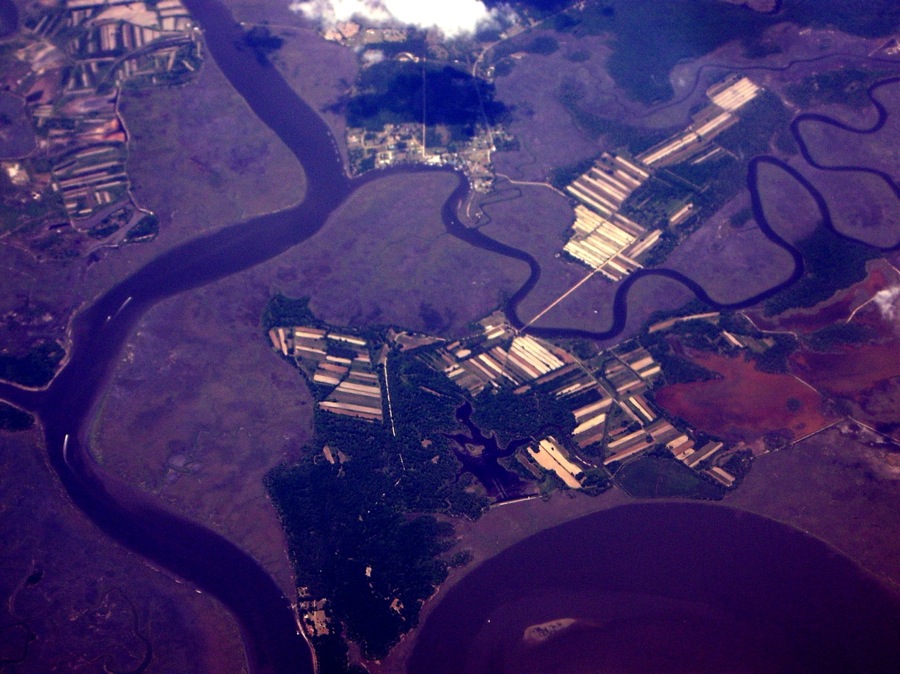

Introduction
"A natural reciprocal nurturing of ocean and earth
creates abundant wildlife in coastal wetlands. Here, salt and fresh
water flow together in tidal marshes, creating rare shorelines of unsurpassed
natural fertility by converting solar energy into food. Swelling tidal
fluctuations recycle vital nutrients that encourage rapid vegetation growth
followed by quick decay..... Both native and migratory wildlife thrive
on the tide-mulched marsh grass fields."
Siry, p. 3.
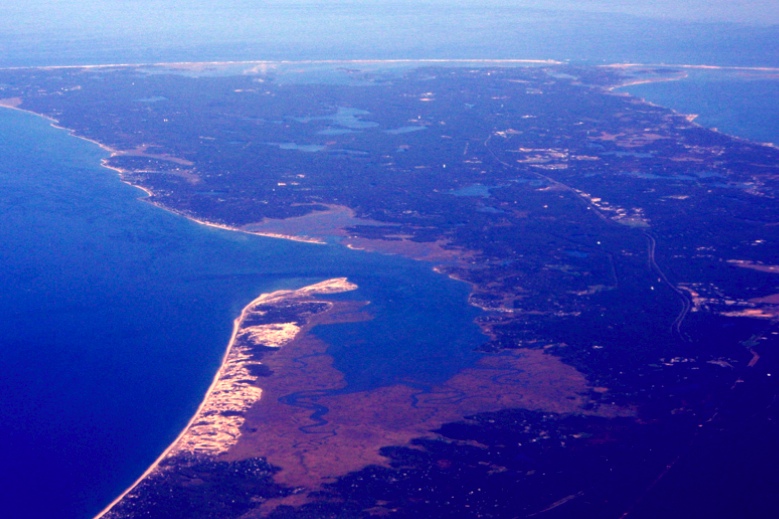
Plains of Nauset on the north side of Cape Cod, the tidal marsh grass is rust colored behind the white sand dune field and the very dark blue of the inland forests.
Estuaries, or mouths of rivers
as they enter the sea, are a geographical unit of enormous, historical
importance because of their ecology, cultural transformation and numerous
economic values.
pictorial views of river mouths and the points in the book.
The three phases of development are:
1. Pre-industrial -- colonial: very agrarian pitted against wilderness and Indians
2. Industrial -- Early national & 19th century: agrarian pitted against urban values
3. Post industrial -- 1940s: eclipse of the agrarian by urban values pitted against suburban values
The Renaissance and agrarian views of the marsh lands as useless commons was counter to the ancient appreciation of their role in fostering fisheries and building materials. These ancient views were being replaced, mistakenly, by policies in the European Renaissance that promoted reclamation --or the drainage of coastal marshes for agriculture. This policy of converting wetlands from common property into private agricultural lands was discovered later in the twentieth century to be a mistake. As private agricultural lands were converted into commercial and industrial sites, pollution killed fisheries and dense settlement destroyed the water quality that sustains a healthy marsh.
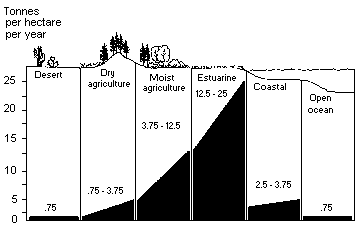 By the 1960s this loss of productive coastal wetland situation was recognized by more and more people based on the scientific evidence of a few ecologists. Among open space advocates, bird watchers, and seaside home owners, protection as a cause that required the preservation of marshes as flood control and storm protection areas, and for their scenic and ecological values in sustaining clean water, health fisheries, bird rookeries, and unsurpassed varieties of lucrative recreation.
By the 1960s this loss of productive coastal wetland situation was recognized by more and more people based on the scientific evidence of a few ecologists. Among open space advocates, bird watchers, and seaside home owners, protection as a cause that required the preservation of marshes as flood control and storm protection areas, and for their scenic and ecological values in sustaining clean water, health fisheries, bird rookeries, and unsurpassed varieties of lucrative recreation.
"Throughout the nation today a series of
state and federal estuarine refuges exist as quiet testimony to the ideals,
efforts and commitment of local conservation groups, planners, engineers,
and scientists. These advocates possess a resolute maturity in asserting
that some places must be set aside for future generations because, as Rachel
Carson once remarked, 'man's way is not always the best.' " (p. 17.)
Top | Introduction | 1 | 2 | 3 | 4 | 5 | 6 | 7 | 8 | 9 | Themes | Thesis | Vocabulary |

Thesis
Viewed since the Renaissance in Europe and the
colonial period in the Americas as obstacles to be overcome, coastal wetlands
were altered, filled and drained as beneficial examples of human achievement
until the mid twentieth century. By then ecologists determined these natural
areas were a source of biological wealth of an unsurpassed magnitude compared
to other ecosystems.

Top | Introduction | 1 | 2 | 3 | 4 | 5 | 6 | 7 | 8 | 9 | Themes | Thesis | Vocabulary |
Themes
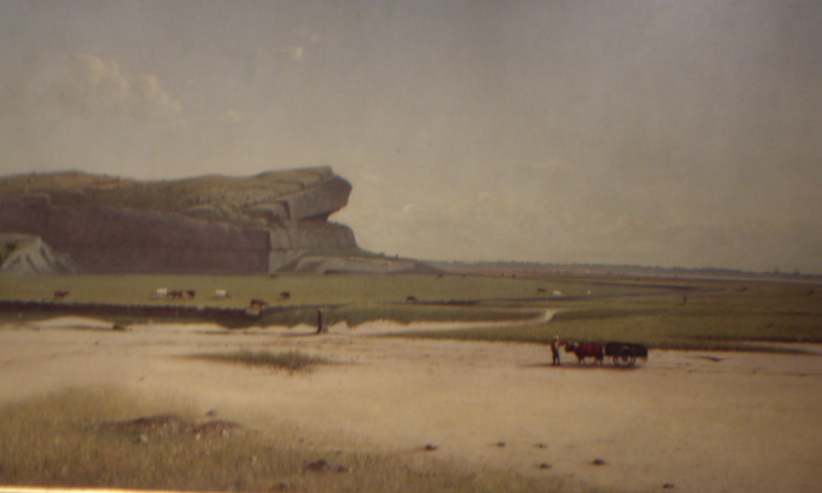
Each age or period defines natural features, economic
value, resources and laws differently depending on their technological capacity, uses, and
knowledge of their surroundings.
There is a legacy in American, English and Roman legal
theory, or jurisprudence that articulated a perpetual public interest in
certain landscape features based on their character, geography, topography
and functional processes.
Geographical information grew slowly in America, but was
seen from the time of colonial settlement and later by John Quincy Adams
as an overriding responsibility of a central government to provide society
with adequate surveys, maps, topographical and bathymetric information
and the location of useful resources.
Technology is a two-edged
sword allowing for the accumulation of knowledge and expanding the capacity
to alter our surroundings to better suit human demands, both material and
spiritual. Science, or the knowledge
of physical, chemical, geological and biological information about the
universe, has the capacity to alter our sensitivities to the world around
us.
Population growth, transportation
demands, increasing wealth and the demand for a greater variety of leisure
activities all converged after world war two placing unusually sharp and
conflicting demands on limited coastal, river and natural resources. United States population growth was among the fastest in the world.
Despite what some historians have suggested concerning
the origins of conservation emerging from a concern for parks, forests
and agriculture, there is evidence to show that fisheries, wildlife and
river pollution as these affected human health and urban development were
equally old sources of the impulse to protect natural areas from damaging
intrusions. Both fisheries and wildlife protection are examples of preservation.
Preservation of cultural
and natural resources predated the rise of conservation in North America.
Conservation arose late in the 19th century and referred to both a keeping
from harm and the wise use of natural resources for the long-term and most
beneficial uses by a majority of the population. Two paramount achievements of conservation were forestry restoration and reclamation in the late 1880s. Preservation of valued
naturally significant or culturally memorable places can be dated to before
the Civil War.
In both the redesign of urban landscapes and the necessity of
controlling rivers along an entire watershed, the emergence before the civil
war of a practice restoring natural harmonies arose and was later characterized
as "geographical regeneration," by George Perkins Marsh-- the "fountainhead of the conservation movement."

Chapters: 1 | 2 | 3 | 4 | 5 | 6 | 7 | 8 | 9 |
1 • Estuarine Marsh: a crib of life nestled in the seas' arms.
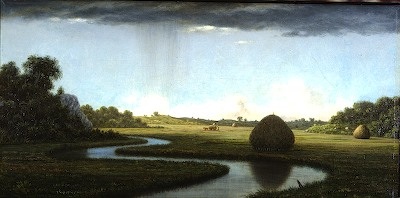 "The river valleys of the Atlantic shore cut through
the coastal plain, creating large numbers of estuaries, many of which are
bordered by extensive tidal marshes. These coastal wetlands have been held
in public trust since the original colonial grants. Unlike rights in other
portions of the public domain, the public rights to fishing, hunting, and
navigation on tidal lands could not be extinguished by sale to private
concerns." (p. 18.)
"The river valleys of the Atlantic shore cut through
the coastal plain, creating large numbers of estuaries, many of which are
bordered by extensive tidal marshes. These coastal wetlands have been held
in public trust since the original colonial grants. Unlike rights in other
portions of the public domain, the public rights to fishing, hunting, and
navigation on tidal lands could not be extinguished by sale to private
concerns." (p. 18.)
2
• Marsh lands along the coast are sites of our oldest commons.
"Even prior to the nineteenth century the necessity of
marshes was disregarded in favor of a continued reliance on estuarine dredging
and coastal reclamation. As the image of the garden symbolized the eighteenth
century intellectual recognition of humanity's role in taming and cultivating
wild landscapes, the creation of a seaside agrarian environment encouraged
the replacement of swamps and marshes with diked meadows or farmlands.
Urban growth, too, fostered dumping, drainage canals, wharves and commercial
shoreline development. As diseases repeatedly swept the crammed and dingy
tidewater cities, the pastoral image of the garden became a paramount influence
on scientists and writers, relegating noxious and obstructing coastal wetlands
to a role as inefficient backwaters." (pp. 32-33.)
3 • The origins of a perpetual public interest in tidal wetlands.
"Tidelands, however, represented a complex problem
of public administration depending on the coastal territory in question.
The proprietary responsibility for these wetlands that had existed in the
colonies was derived from the crown, to be held in perpetual trust for
the promotion of navigation and the public privileges of fishing and hunting."
(p. 39.)
4 • Commerce & the Public Trust: An organic revolt against "laissez faire."
National sympathy for protecting nature dramatically appeared
among elite professionals before the Civil War. These preservation advocates
conceived the intellectual and tactical foundations of future federal resource
protection policies -- especially for fisheries, wildlife, land and water.
(p. 62.)
5 • The restoration of disturbed harmonies. G. P. Marsh
"After the War between the States, the doleful predictions
of George Perkins Marsh concerning fisheries and estuarine habitats churned
in the mind of his confidant and supporter, Spencer Fullerton Baird. As
a naturalist and assistant director of the Smithsonian Institution, Baird
knew that sport and commercial fisheries were dependent on anadromous fish.
These fishes lived most of their existence in the sea but required the
fresh-water river sources to spawn the next generation of salmon, herring,
or shad. Often the juveniles of these species lingered in the estuaries,
where a rich supply of food, nourished the young." (p. 83.)
6
• The New Ecology engendered The New Ecological Ethic
"At the turn of the century ecology and economics agreed
on the classification of tidal marshes as obstructing wastelands. Resource
economics determined the 'best' use of land solely from the human and utilitarian
perspectives. The initial findings of terrestrial and marine biologists
supported policies to make human 'improvements' over nature's perceived
inefficiency. However, in the 1930s and 1940s a number of scientists, including
wildlife biologist, Aldo Leopold, would begin to demonstrate that the political
and economic values assigned to coastal wetlands and other wild areas conflicted
with their biological integrity." (p.112.)
7 • Estuaries and The New Ecology
"The expansion of wisdom is a difficult task for an 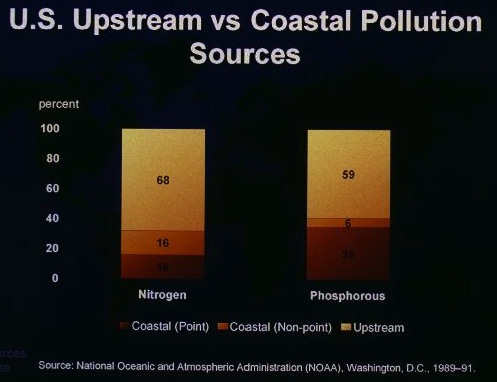 individual,
let alone a society. In democratic cultures wisdom often may be overlooked
at the voting boot in the formulation of policy. For citizens and civil
servants alike, confronting popular notions of efficacy and justice takes
courage. Rachel Louise Carson was an advocate of unpopular causes, including
fish and bird protection, preservation of wild seashores, and opposition
to heedless use of 'miracle' technologies. Her final, best known attack
on the indiscriminate uses of DDT as an insecticide was only one part of
her larger and more positive view of the world and humanity's place in
the eco-energetic scheme.... More than any other scientist she popularized
the oceans and the shores, with a profoundly religious respect for nature
and a practical appreciation for human ignorance. A contemporary of her
fellow preservation ecologist, Aldo Leopold, Carson focused more explicitly
than he on oceans and shores." (p. 134.)
individual,
let alone a society. In democratic cultures wisdom often may be overlooked
at the voting boot in the formulation of policy. For citizens and civil
servants alike, confronting popular notions of efficacy and justice takes
courage. Rachel Louise Carson was an advocate of unpopular causes, including
fish and bird protection, preservation of wild seashores, and opposition
to heedless use of 'miracle' technologies. Her final, best known attack
on the indiscriminate uses of DDT as an insecticide was only one part of
her larger and more positive view of the world and humanity's place in
the eco-energetic scheme.... More than any other scientist she popularized
the oceans and the shores, with a profoundly religious respect for nature
and a practical appreciation for human ignorance. A contemporary of her
fellow preservation ecologist, Aldo Leopold, Carson focused more explicitly
than he on oceans and shores." (p. 134.)
8 • Politics and The Preservation of Estuaries
"The pejorative implications of the words morass, slough,
muck and miasma still associated with wetlands need no comment, These terms
are common synonyms for obstruction, nuisance and disease. Yet as part
of the national 'battle to preserve the common estate,' coastal marshes
and tidal flats became the focus of a major drive for the protection of
natural resources during the late 1950s."
(p.157.)
9, • Americans and The Tidal Seas
"As the American nation has grown older, its attitudes
toward its natural resources have changed and matured. Its legal underpinnings
for environmental policies have been reinterpreted and reformulated to
accommodate the changing understandings and values. The estuarine preservation
ideal that emerged in the mid- to late 1960s is one of the most recent
developments in American ideas concerning resource stewardship."
(p. 188.)

Vocabulary
C, L,
Su, W.
Algae - single celled organisms
that account for productivity in certain ecological systems because they
can photosynthesize water, carbon dioxide and light from the sun. They
form the base of many aquatic and marine food chains. i.e. Diatoms.
Bay - a relatively shallow extension
of the ocean into the land lying adjacent to the continental shelf.
Beach - a deposition of sand along
a shore line, often the quartz, coral or volcanic material of small grain
size beside the sea.
Barrier Island - areas along usually
sinking coastlines with very high wave energy that piles up sand or pebbles
along the shore in such a way that the island forms a dam between the dry
land of the continent and the ocean.
Coastal - from
the Latin word "costa" meaning the edge. In this case the border of the
land where it meets the sea, ocean or some other large body of water.
Detritus - technical term for decayed
or decaying vegetational, plant and fungal material derived from land or
sea creatures that is carried by currents generated by tides or falling
water or blown across distances by prevailing winds.
Edge effect - [ beside, side by side communities that differ]
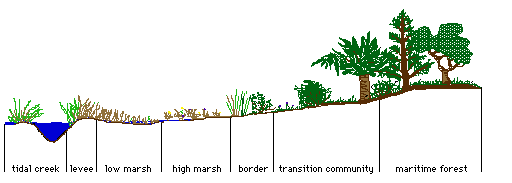 the idea in ecology
that a transition area between two different ecological associations, such
as water and land in wetlands, or a forest and a grassland, is often more productive because of a greater
number of species from each of the adjacent areas utilize the boundary
between those areas to
the idea in ecology
that a transition area between two different ecological associations, such
as water and land in wetlands, or a forest and a grassland, is often more productive because of a greater
number of species from each of the adjacent areas utilize the boundary
between those areas to 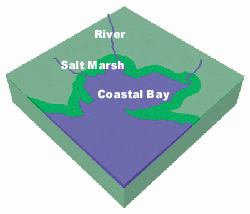 acquire sustenance.
acquire sustenance.
Estuary - a
coastal body of water where a river meets the ocean and thus a brackish
mixing area of fresh water drainage with higher salinity marine water.
Estuaries sustain greater populations of plants and animals than equivalent habitats along the coast and rival the productivity if not the diversity of organisms on coral reefs.
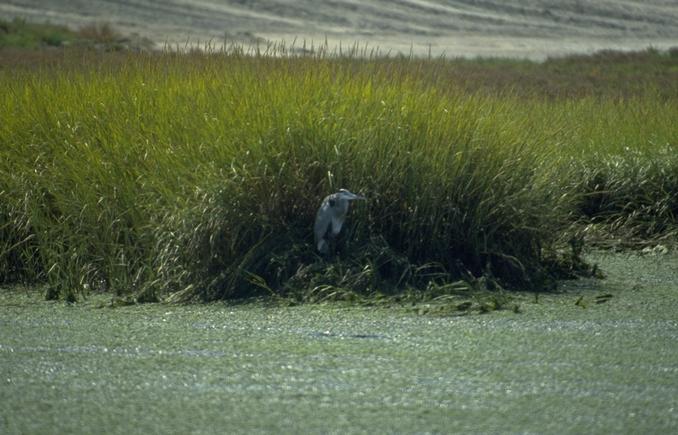
Filter feeder - an organism, generally
aquatic, marine, or estuarine, that exists by filtering out the medium
in which it lives and extracting detritus which is rich in nutrients, vitamins
and minerals for nutrition. A major contributor to the food chain in salt marsh areas,
or coastal bays where clam banks and oyster beds thrive, or where barnacles, limpets and mussels persist on rocky shores, or worms, clams and cockles burrow in the
mud flats, or scallops in the bays or deep seas.
Lagoon - usually
a coastal body of water that has a higher salt concentration than the adjacent
ocean or rivers.
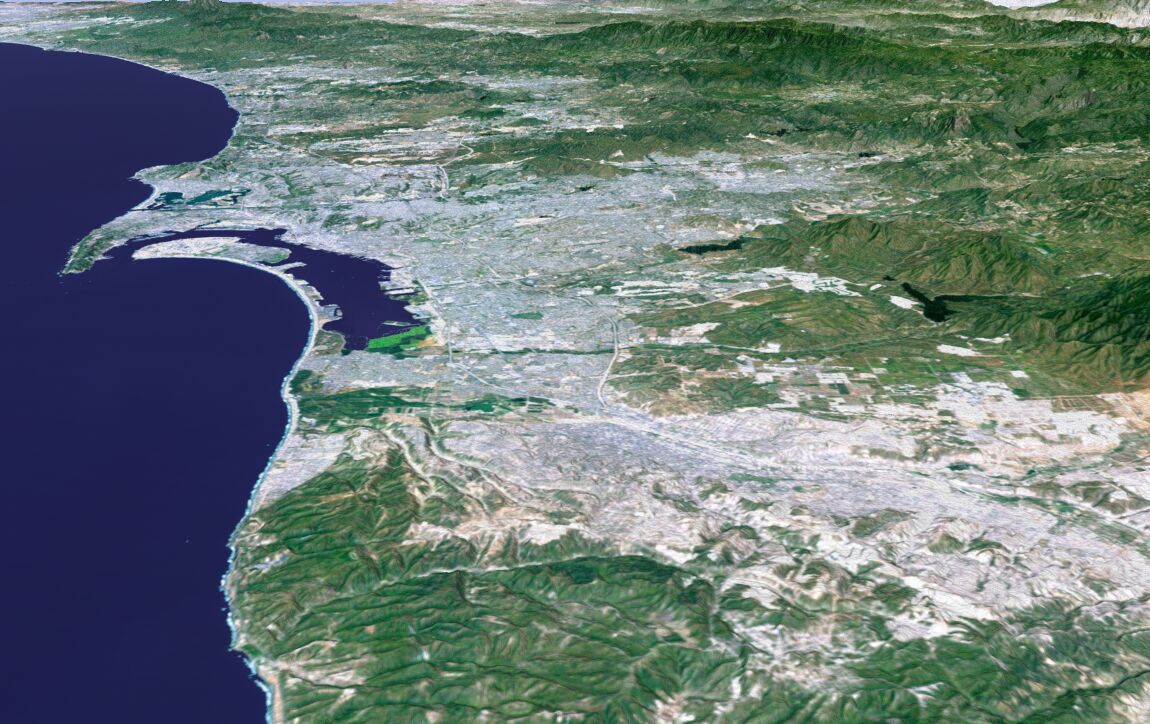
San Diego Bay shown above is lined by lagoons where salinity levels are often higher than in the ocean because of evaporation and limited fresh water flow from seasonally dry streams.
Littoral - refers to the shoreline,
derived from the Latin word for the shore, bank, or edge of a water body.
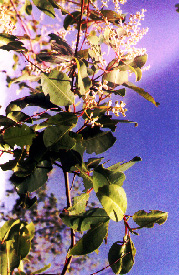 Mangrove - a type of tropical marine shore
vegetation that often dominates estuaries and is characterized by evergreen
trees of very
distinct species that can under optimal climatic conditions form a dense
canopy forest that is a main contributor to the nutritional productivity
for shrimp, crabs and lobsters; and thus forms one basis of shoreline food
chains in coastal tropical areas.
Mangrove - a type of tropical marine shore
vegetation that often dominates estuaries and is characterized by evergreen
trees of very
distinct species that can under optimal climatic conditions form a dense
canopy forest that is a main contributor to the nutritional productivity
for shrimp, crabs and lobsters; and thus forms one basis of shoreline food
chains in coastal tropical areas.
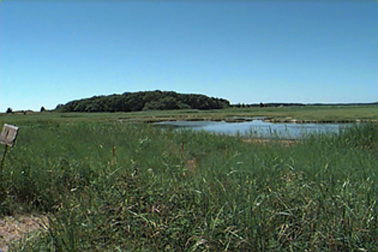 Marsh - a type of temperate marine,
estuarine and lake or river shoreline vegetation characterized by water
tolerant grasses, reeds, algae and blue-green bacterium. Usually a nursery,
or breeding, or feeding area for fish, birds and other wildlife.
Marsh - a type of temperate marine,
estuarine and lake or river shoreline vegetation characterized by water
tolerant grasses, reeds, algae and blue-green bacterium. Usually a nursery,
or breeding, or feeding area for fish, birds and other wildlife.
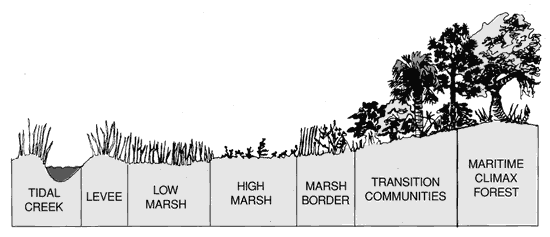
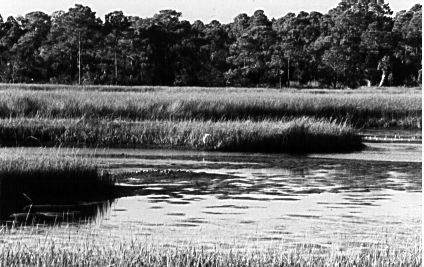 Mud flat - deposited
fine grained material, usually found where sluggish current or no current
at all allows silt (fine grained sediment) to settle to the bottom of a
water body along a river, lake or particularly beside tidal streams.
Mud flat - deposited
fine grained material, usually found where sluggish current or no current
at all allows silt (fine grained sediment) to settle to the bottom of a
water body along a river, lake or particularly beside tidal streams.
Optimum, law of - based on the studies of Justus Liebig the 19th century discoverer of the aniline dye industry the concept comes from his "law of the minimum." That is the chemical nutrient often needed in the very smallest amount is the necessary ingredient to create a nourishing condition. Known as a founder of the fertilizer industry Liebig recognized that the capacity of a field to produce was thwarted by the scarcest trace elements and not limited so much by what is abundantly available. Thus the optimal production in natural systems is not more and more productivity but actually how great a yield can flourish when a deficiency in a necessary element is present. He insisted that the very production may cease due to a lack of the least available, but most important, or limiting ingredient in the process; such elements as magnesium in green plants or phosphorus, calcium, or sulfur even where carbon, or compounds of water and nitrogen are abundant.
Source: http://www.soils.wisc.edu/~barak/soilscience326/lawofmin.htm
Public Trust Doctrine - derived from
Roman and English Common Law, a legal body of decisions holding that in
certain designated natural areas, such as the bottom of rivers, lakes,
streams and estuaries, land --that is or can be covered seasonally by water--
is of such great importance that its ownership is held by no one person
and thus its use is restricted by law.
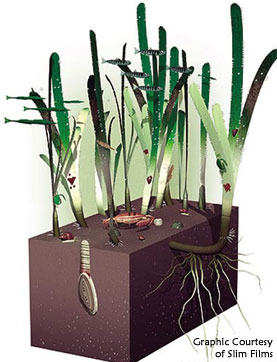 Sea grass - a type of flowering plant
that grows in shallow marine or estuarine water where sunlight may penetrate
to the bottom --or substrate-- of the basin.
Sea grass - a type of flowering plant
that grows in shallow marine or estuarine water where sunlight may penetrate
to the bottom --or substrate-- of the basin.
Shown or depicted here on the left.
Spartina grass - a type of flowering
plant that occupies the 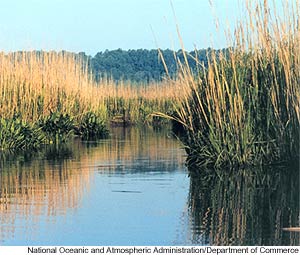 estuarine, or river marshes along shores with a
temperate climate.
estuarine, or river marshes along shores with a
temperate climate.
Spartina grasses of two different species –alterniflora & patens– are shown or depicted here on the right; alterniflora is taller along the shore & patens– is shorter and inland.
Sound - an unusually constricted,
or closed in body of marine water that floods into coastal areas.
Sovereign lands - By application
of English custom derived from Roman law, those areas of submerged land
that belong to the King, Queen, Emperor, Empress, or some other plenary
authority exercising absolute power over subjects in a designated territory.
In the US practice these are property of the states and refer to property
beneath any water body of significant size.
Succession -
the idea in ecology that vegetation and climate can over a very long period
of time, several generations of plants and animals, alter the underlying
conditions of soil (substrate), nutrients, and available sunlight as to
change the association of dominant plants and fungus. With these vegetational
changes over time comes an alteration of the animals dependent on plants
and soil nutrients for their sustenance.
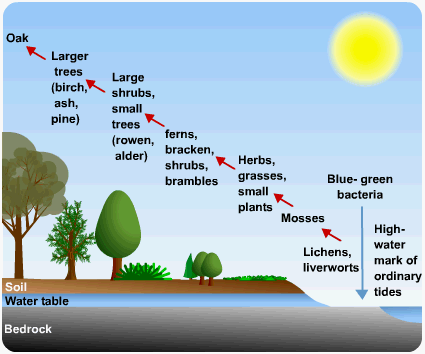
Succession was first described by Clements along the shores of Lake Michigan.
Sub littoral zone - that area below
the water level at all times of the year. Basically submerged areas along
a shore.
Tide - the daily changes in the surface
elevation of the sea with respect to the land lying along the shore.
Tidelands - generally the area along
a river affected by the daily fluctuation of ocean tides; specifically
the name given to oil leases in state waters extending from below the tide
line out over the continental shelf to the three or ten mile limit depending
on the state in question. A controversy that arose after world war two
over the federal and state control of oil drilling leases under the ocean.
decided in favor of the several coastal states.
Tidewater - that extensive land area
of the Eastern United States form roughly Boston, Massachusetts to Brownsville,
Texas, where the affects of the sea with reference to the land lying along
the shore of estuaries, bays, rivers and streams is so pronounced that
small sailing vessels may ride the tide in both an upstream or a downstream
direction depending upon the flood or ebb of ocean waters.
Trophic levels - the arrangement of food chains in areas, but more complex in estuaries and along edge communities.
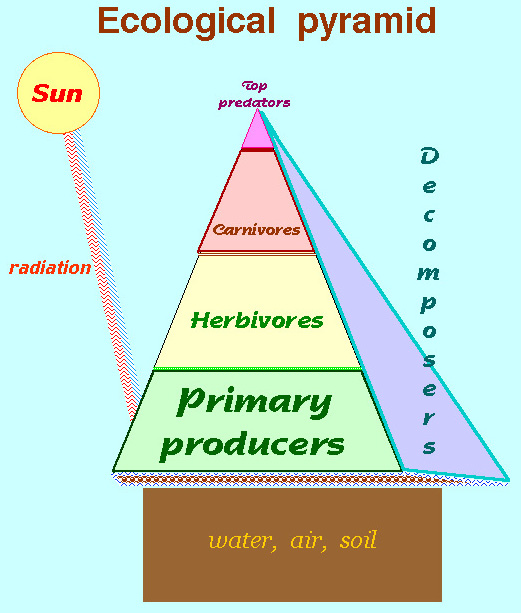
Wetland - officially
designated vegetational areas that have soil characterized by seasonal
or periodic flooding, and that tolerate permanent or fluctuating water
conditions over time (called a hydro period). Otherwise a kind of oxymoron
that suggests nature is more complicated than our language is capable of
cleverly expressing in sufficient detail.
Zonation - the name given in ecology
and natural history to the pattern of vegetational associations according
to specific features of a habitat or area with respect to elevation, substrate
(soils), water, slope, or sun angle.
A, C, L, M.
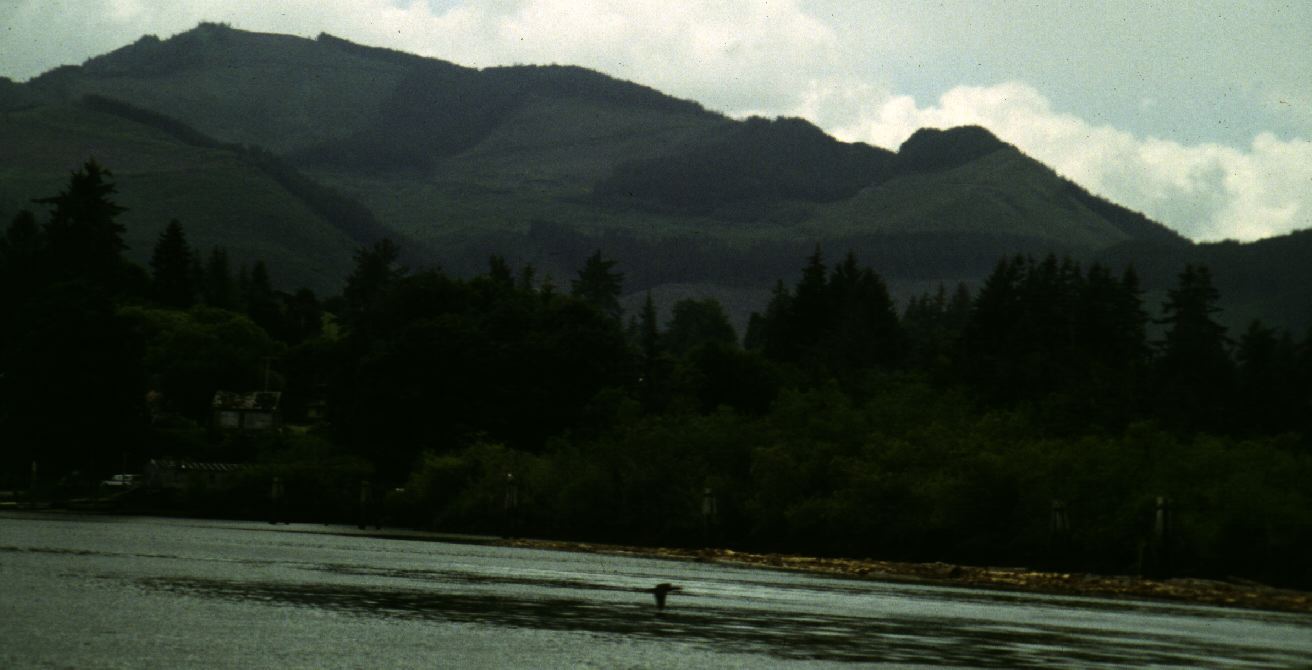
Top | Introduction
| 1 | 2 | 3 | 4
| 5 | 6 | 7 | 8
| 9 | Themes | Thesis
| Vocabulary |
Productivity of estuaries
Restoring Coastal America

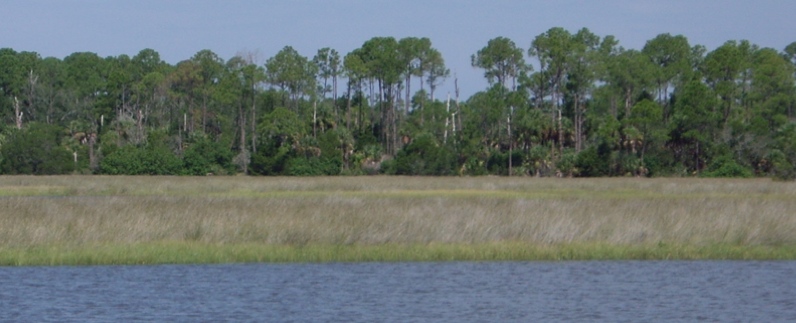





 the idea in ecology
that a transition area between two different ecological associations, such
as water and land in wetlands, or a forest and a grassland, is often more productive because of a greater
number of species from each of the adjacent areas utilize the boundary
between those areas to
the idea in ecology
that a transition area between two different ecological associations, such
as water and land in wetlands, or a forest and a grassland, is often more productive because of a greater
number of species from each of the adjacent areas utilize the boundary
between those areas to 





 Mud flat - deposited
fine grained material, usually found where sluggish current or no current
at all allows silt (fine grained sediment) to settle to the bottom of a
water body along a river, lake or particularly beside tidal streams.
Mud flat - deposited
fine grained material, usually found where sluggish current or no current
at all allows silt (fine grained sediment) to settle to the bottom of a
water body along a river, lake or particularly beside tidal streams. Sea grass - a type of flowering plant
that grows in shallow marine or estuarine water where sunlight may penetrate
to the bottom --or substrate-- of the basin.
Sea grass - a type of flowering plant
that grows in shallow marine or estuarine water where sunlight may penetrate
to the bottom --or substrate-- of the basin.


